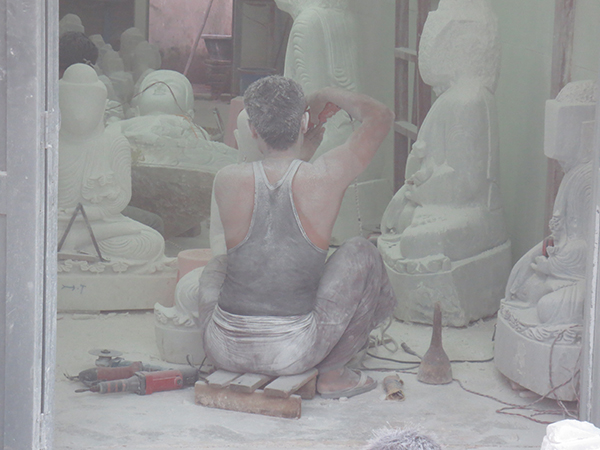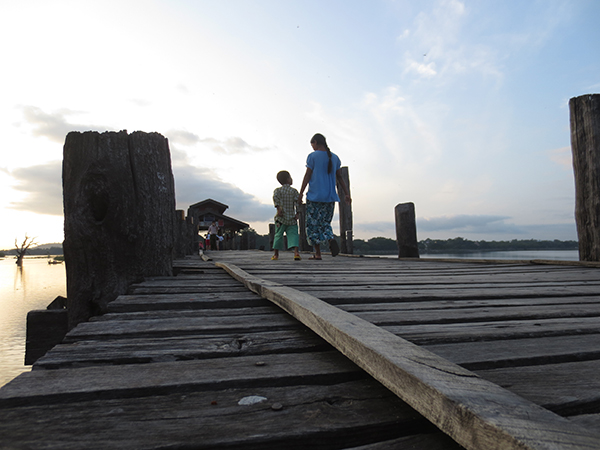Mandalay
 There are a lot of cultural sights to see in Mandalay, yet I didn’t have high expectations for this city. Mandalay is the second largest city of Myanmar, so what I expected was a busy crowded city, full of dust, pollution and traffic. And it is true that Mandalay was all of that, but it was also so much more.
There are a lot of cultural sights to see in Mandalay, yet I didn’t have high expectations for this city. Mandalay is the second largest city of Myanmar, so what I expected was a busy crowded city, full of dust, pollution and traffic. And it is true that Mandalay was all of that, but it was also so much more.
The sights for Mandalay are quite far apart from one another. The most common way to get from one place to another is by hiring a motorbike (with driver). Motorbikes serve as taxis in Mandalay. I was very fortunate to meet a great driver on my first ride. I was going to the Mandalay palace and not only did the driver charge me less than anyone else for the trip, but he also insisted on waiting for me until I was done with seeing the palace. So we ended up spending the whole day together (and the following days) with him driving me somewhere, waiting for me until I am done and then driving me somewhere else. The whole journey cost me about $8-$10 per day. In addition, my driver also acted as local guide and had fantastic suggestions about where to go.
So the first place he took me was the Mandalay palace, which was the royal palace of the last Burmese monarchy. It was constructed in 1857 and acted as the residence for the two last kings till 1885 when the British got hold of it. Sadly, it was mostly destroyed during the 2nd world war with only the watch tower remaining. I really do believe that whoever orders bombs to be dropped on historic monuments should be tried for war crimes… Such a shame… The Burmese have since rebuilt the complex (mainly for tourists), but I must say that the palace is not well maintained and appears unnecessarily kitsch. Regardless, it was a fun outing and the palace museum had a collection of incredible photographs of what everything once looked like.
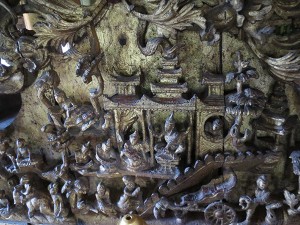 After the palace, I went to see the impressive Shwenandaw Monastry. It was built in 1880 and is the only remaining major original structure of the Royal Palace today. The reason it is still standing today is because it was relocated several times within Mandalay and other former capital cities. It was once gilt with gold and adorned with glass mosaics that are all gone today, but the impressive teak carvings inside of it and on the roof are still there today.
After the palace, I went to see the impressive Shwenandaw Monastry. It was built in 1880 and is the only remaining major original structure of the Royal Palace today. The reason it is still standing today is because it was relocated several times within Mandalay and other former capital cities. It was once gilt with gold and adorned with glass mosaics that are all gone today, but the impressive teak carvings inside of it and on the roof are still there today.
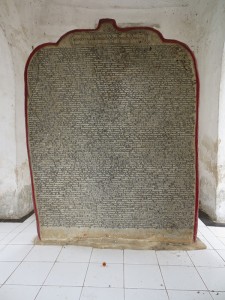 My next stop was the Kuthodaw Pagoda, also known as the world’s largest book. It’s a complex of 729 stupas, each of them containing a marble slab that is inscribed on both sides with text from the Tipitaka (Buddhist teaching). It was also built in the late 1800 and took many years to complete. The inscriptions were once written with golden ink, of course the gold was stolen over the years.
My next stop was the Kuthodaw Pagoda, also known as the world’s largest book. It’s a complex of 729 stupas, each of them containing a marble slab that is inscribed on both sides with text from the Tipitaka (Buddhist teaching). It was also built in the late 1800 and took many years to complete. The inscriptions were once written with golden ink, of course the gold was stolen over the years.
I also took a stroll in the district of craftsmen. In the first workshop, people were making the gold leaves that men paste on various buddhist monuments (like the pagodas and the golden rock). They are made using tiny pieces of gold that strong men pound for dozens of hours to flatten it. Women then take care of cutting the thin sheets of gold into tiny pieces that the men then pound again. It takes several iterations of pounding and cutting until the sheets are so thin that an average Burmese can afford to buy them. Next to this atelier were many other interesting shops of people carving wood, making leather jackets, packaging cups etc. It was probably my favorite area of Mandalay and every one of these craftsmen and women welcomed me with open arms and was delighted to show me around in their workshops.
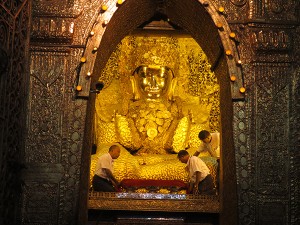 My final stop was the Mahamuni Buddha Temple, which is one of the most important pilgrimage sites in Myanmar. The center piece of the temple is a giant golden Buddha that people further adorn with gold leaves. There are lots of legends associated with this statue. Although the statue is beautiful and impressive, I found it hard to remain appreciative of all the golden structures in Myanmar (golden pagoda of yangon, golden rock, golden buddha etc).
My final stop was the Mahamuni Buddha Temple, which is one of the most important pilgrimage sites in Myanmar. The center piece of the temple is a giant golden Buddha that people further adorn with gold leaves. There are lots of legends associated with this statue. Although the statue is beautiful and impressive, I found it hard to remain appreciative of all the golden structures in Myanmar (golden pagoda of yangon, golden rock, golden buddha etc).
Around the Mahamuni temple was a whole district were people were carving giant marble statues. It was really beautiful to watch them. The white marble dust was everywhere and as it covered the workers, these became like moving white statues themselves.
These are some of the sights of Mandalay. There are also many sights around the city of Mandalay that are worth the detour. So for one full day, I hired my favorite motorbike driver to take me to the surrounding cities.
 First my driver brought me to the Maha Ganayon Monastery, it’s a popular stop for tourists to see the monks line up for lunch. But once I arrived there and saw all of the tour buses and the hundreds of tourists waiting with their cameras for the monks to show up, I immediately told my driver to take me somewhere else. I suggested he take me to the Paleik snake monastery instead. He looked at me in disbelief for a while and then smiled and said “no problem”. Basically, the Paleik monastery required a big detour. In fact it was so far out of the way that there were only local tourists there, but it was also worth it. Two giant snakes live in this monastery and every day, the monks wash and feed them. Dozens of local tourists make the trip to watch this ceremony.
First my driver brought me to the Maha Ganayon Monastery, it’s a popular stop for tourists to see the monks line up for lunch. But once I arrived there and saw all of the tour buses and the hundreds of tourists waiting with their cameras for the monks to show up, I immediately told my driver to take me somewhere else. I suggested he take me to the Paleik snake monastery instead. He looked at me in disbelief for a while and then smiled and said “no problem”. Basically, the Paleik monastery required a big detour. In fact it was so far out of the way that there were only local tourists there, but it was also worth it. Two giant snakes live in this monastery and every day, the monks wash and feed them. Dozens of local tourists make the trip to watch this ceremony.
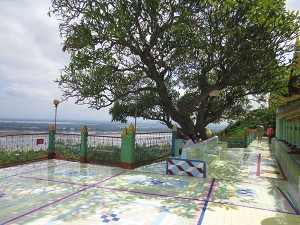 My second stop was a hill in the city of Sagaing that has roughly 500 pagodas on it, some of which dating back to the 13th century. To get to the hill, you have to climb 1729 steps. I wasn’t particularly impressed by the pagodas, but the view from the hill was very beautiful.
My second stop was a hill in the city of Sagaing that has roughly 500 pagodas on it, some of which dating back to the 13th century. To get to the hill, you have to climb 1729 steps. I wasn’t particularly impressed by the pagodas, but the view from the hill was very beautiful.
From there, I went to the city of Inwa that was Myanmar’s capital from the 14th till the 18th century. You have to get to this “city” (really just a few ruins in the middle of nowhere) by boat. Once on the other side, many horse carts wait to take tourists around. I first attempted to resist the horse cart business by simply walking away. But the path to the temple was so muddy that I barely made 300m before I gave in. In the end, it is true that a horse cart or motorbike are the only way to visit this place, because the sights are so far away from one another. Inwa was one of my favorite places, in some ways it reminded me of Bagan. The ruins were in the middle of nowhere, lost in the rice fields. It felt like a world apart, much quieter and calmer than Sagaing that was just on the other side of the river. I really wish I could have spent a full half day or day exploring this area. But the usual horse cart tour only takes you to the four main sites: the Bagayar monastry that has many impressive teak carvings, the watchtower, the city wall, and the Maha Aungmyay Bonzan monastry. All of them were really beautiful. But we also crossed many villages and other small ruins in rice field that I would have wanted to stop at if I had had the time for it.
My final stop for the day was the city of Amarapura and the U Bein Bridge. The bridge is 1.2km long and believed to be the longest teakwood bridge in the world. I could not have imagined a better way to end the day and my trip to Myanmar. Watching the sunset from the bridge felt really magical, as if you were witnessing a scene from a fairytale book, many worlds apart from my regular day-to-day life and a rare treasure in our modern world.
Myanmar… I can’t rave enough about this country. Although people have suffered so much in this country, they welcome you with dignity and infinite kindness. I have been wanting to go to Myanmar for the past ten years and I am so glad I finally made the detour. I didn’t realize how rich the kingdom of Myanmar once was. I believe several of the sights in Myanmar should be on the list of world wonders. Myanmar still has a strong identity and has not yet fallen under the western influence. I feel fortunate to have been able to witness this wonderful place. Looking back, Myanmar was the highlight of my trip.
See more photos here.
This entry was posted on Saturday, December 28th, 2013 at 1:59 pm and is filed under Travel Stories. You can follow any responses to this entry through the RSS 2.0 feed.




